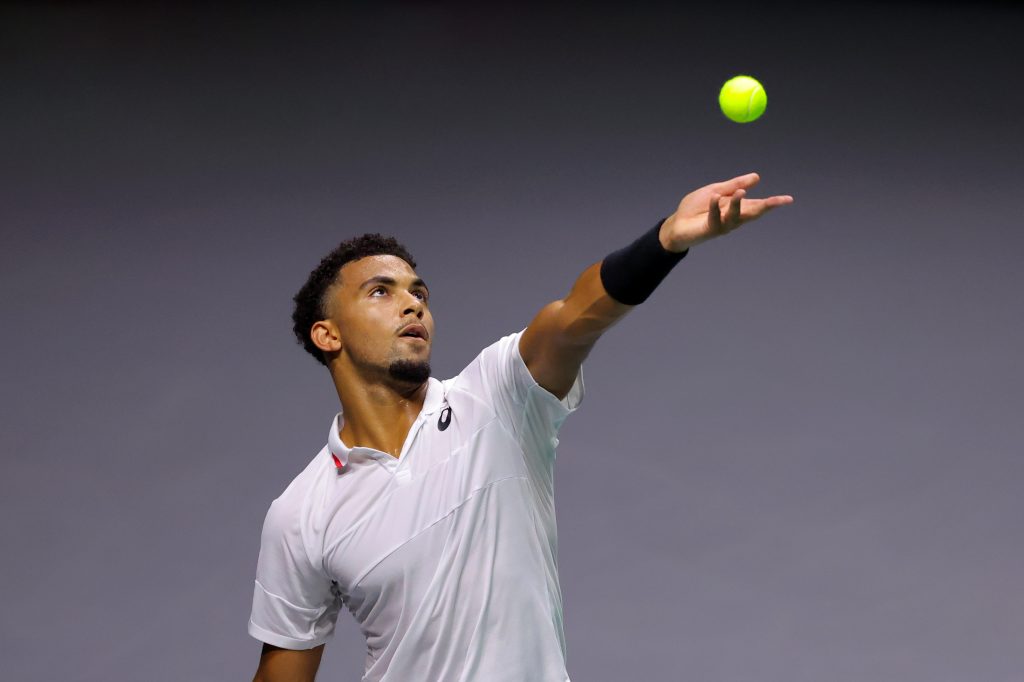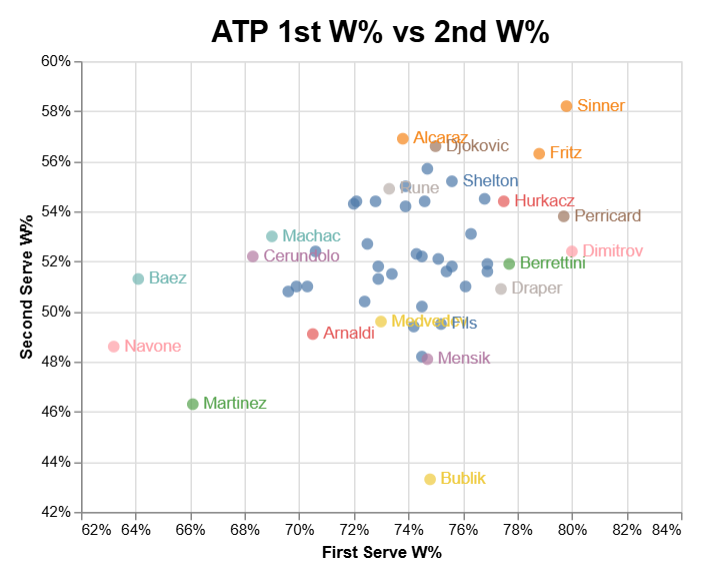
Arthur Fils is a little forgotten prospect. A year younger than Carlos Alcaraz and two years older than Joao Fonseca, he is not considered an amazing talent. Then, who did? According to any other standard, a 20-year-old Frenchman has made huge progress. Standing on #19 on ATP computer and is the best player under 21 years of age and even within Top five up to 23 years of age.
There is no secret in Fils. Hits hardlySmacking serves more than 130 miles per hour and occasionally connects with the forehead, which could even cause Fonsec’s eyebrow. On Saturday’s match Davis Cup against Thiago Seyboth Wild, 11 ES recorded only 54 service points. When he unloaded his first service, he scored 29 out of 32 points.
The Frenchman has much more in his game. It is robust at both wings, not afraid to fight from the base line. He the measurement +5 v CupHardly the leading tour number, but better than Daniil Medvedev and Holger Rune. From the same metric is his backhand neutral. This is another number that looks better in the context: it will not receive any awards, but the shot does not hold it back.
At first glance, his greatest challenge is his greatest challenge. Over the past 52 weeks he has won 36.2% of the return points, which is a number just below the usual minimum For an elite player. It ranks him above the rune, Hubert Hurkacz and Taylor Fritz, but for Most of his colleagues from the best 20 players. However, it is not an obstacle to the rupture of the top ten, as Hurkacz and Fritz showed.
The problem of fils now is what happens when he misses this big first serves. Among the 50 best ATPs, which was placed on the 16th place in the winning points on the first series, just in front of Karen Khachas. According to the second-Serve points won, ranks on Dire 43., several places down from the list Sebastian Baez. Even on Saturday Davis Cup Rout, the French failed to win half of his second ranking points.
What’s the matter? Is it something young players tend to improve? What does the weak point of the second shot say about the next trajectory of the prospect?
Second for many
Let us gain a sense of typical relationship between the first and second extent winning. This variance shows the top 50 ATP in the last 52 weeks:

The players who are successful for one are generally successful for both, while Jannik Sinner led the way in the upper right corner. Carlos Alcaraz and Novak Djokovic will be placed among the leaders’ leaders in the second region, although their first shot results are not so strong. Grigor Dimitrov and Giovanni Motetshi Perricard will pop up as men with effective first serves who do not do so much after the second.
Fils barely sticking out like a disaster, especially with Alexander Bubl, to distract us. Nevertheless, for a man who can win more than three quarters of his first points, he sits in the wrong part of this grid. There is virtually no difference between the results of his first scope and Ben Shelton, yet the American wins five percentage points more often with his other administration. Shelton is primarily in a percentage, while fils disappear outside the top 30, despite the almost identical rate of the first region’s success.
Diagnosis
One thing is to say that the player will not score enough points for his second service. Can we figure out why?
Start with two things not. Fil undertakes more double failures than average: 4.1% of the server dots compared to a typical 50 best rate of 3.4%. But even if it lands on the second serving, the results are disappointing. Instead of 43. Among the 50 best is 37. The place. Less doubles could be nice, but they would barely move the needle.
We can also exceed a particularly soft second that serves from the list. At the US Open last year, Fils reached an average of 115 miles per hour for the first submissions and 92 miles per hour per second. This is an abyss of 23 miles per hour – in accordance with the standard among the players who reached the third round. Jannik Sinner was an average of 91 miles per hour with his other administration, so Raw Speed is not a problem.
That leaves us anywhere The second portions are landings. Unknowingly, I have the impression that the other servants of Fils do not provide particularly deep. For example, Khachanov hits Topspin in second place, but it’s okay because he is constantly falling deep into the corner of the backstage. The French sometimes hit that they serve, but equally often its non -delivery in the center of the box. In 2025 it will not reduce this area.
Match the mapping project data I can’t tell us how deeply serving, but tells us which direction they will go:
Dc-Wide Dc-Body Dc-T Ad-T Ad-Body Ad-Wide Fils 2nds 17.5% 38.1% 44.4% 11.3% 20.4% 68.3%
First, the French rarely goes to the forehead. With a really good second serving, it’s intelligent. But with less impressive strokes, it provides opponents. Last week I got me together with analysis Alcaraz’s loss to Djokovic in Melbourne, where Alcaraz went to the other side after the second – probably too often. This gave Novak flexibility to build differently and aggressively playing revenues. FILS makes a similar offer to everyone it plays, especially on the advertising side.
Secondly, that is a a lot Deuce Court serves in the middle. “Points” is misleading – usually when we talk about body administration, we mean the really good ones, flew 125 miles per hour in the left loin return. This is happening here. A suitable name for this category is something less inspiring, for example, “serves that are not in the corner”. Whether it is a few steps or none at all, it is not satisfied with exceptional return on.
Here are directional disorders of several men with strong second class results, for comparison:
Dc-Wide Dc-Body Dc-T Ad-T Ad-Body Ad-Wide Fils 17.5% 38.1% 44.4% 11.3% 20.4% 68.3% Shelton 27.3% 40.3% 32.4% 21.6% 35.0% 43.4% Djokovic 35.5% 38.8% 25.6% 30.6% 27.2% 42.2% Sinner 14.1% 61.5% 24.4% 15.0% 49.8% 35.1%
Both Shelton and Djokovic mix things much more. Sinner is doing everything I just criticized about Fils, and at least in New York last fall did it at the same speed. A alternated smile of Emodi. Certainly there is more happening, but we will have to store it for the next day.
Development
One way is clear weaknesses a good thing. It is easier to identify a clear target area for practice, how to focus unclearly to improve in everything. I am sure that FIs and his team are aware that he should get more of his second service, and we’ll see him how to change things.
The question is, therefore, whether it is likely that these efforts will bear fruit. Many players are trying to make their statistics meaningfully improving themselves when they establish themselves on the tour. It is quite difficult for the treading of water. Opponents find out how to act against their weapons, age and wear, A-if player is lucky enough to climb the ranking-average opponent in the later rounds is stronger.
Fils compared with Jo-Wilfried Tsonga. Tsonga had never had the level of winning of the second inclusion of the second class, but in the first two years on the tour he had a mean value of around 51.5%. On the other hand, Tsonga was a late flower: when he was 20, he barely played a challenge.
For a more comprehensive answer, I found 75 men who played the whole season on the age of 20 since 1991. All except five of them eventually improved their winnings at the age of 20 and the average improvement was a 2.7 percentage point. If this is true, it will culminate around 52% on the second serving. This is not bad, even if I suspect that he would be disappointed if he was never better. It would still be a lack of performance for someone who has his first weapons.
One -third of these players, who at the age of 20, recorded the second place of winning, has actually improved more than the larger population. They received 3.4 percentage points. These include some names that could inspire even more young French performances:
Player Age 20 2ndW% Peak Peak 2ndW% Andrey Rublev 49.3% 2020 53.9% Nicolas Almagro 49.1% 2012 55.1% Sam Querrey 48.2% 2015 54.1% Tommy Haas 47.7% 2006 54.8%
All four won fewer points of the second class at the age of 20 as Fils in 2024. Each of them has completely increased the weakness-astonishment for one season. 54% is not elite, but it is more than enough good, especially if it is paired with the top first administration.
To clarify this, I did not speak Haas a similar, seven -point improvement for Fils. Repairing weak points at the trip level is extremely demanding and even the standard of the three -drast standard will have a lot of work. However, it is a challenge that the Frenchman will have to have. He went a long way to the back of the big first maid, but to break the top ten, he will need a more well -rounded attack.
* * * *
Sign in to the blog and get each new post e -mail:













